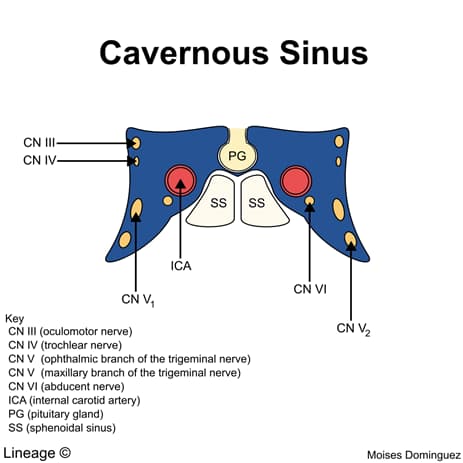Overview

Snapshot
- A 24-year-old female presents with a progressivesly worsening headache and eye swelling. The pain is sharp and one-sided and affects the right forehead and eye. She has tried over-the-counter pain medication with no relief. Her headaches are negatively affecting her sleep. Patient is recovering from sinusitis. On phyical exam, there is eye swelling, right lateral gaze palsy, and hypoesthesia of the V1 and V2 dermatome. (septic cavernous sinus thrombosis)
Introduction
- Venous plexus flanking the pituitary/sella turcica on both sides
- cranial nerves (CN) III, IV, V1, V2, and VI pass through the cavernous sinus
- CN III, IV, V1, and V2 are found in a fibrous sheath found on the lateral walls of the cavernous sinus
- carotid siphon (internal carotid artery) and sympathetic fibers that travel in the carotid plexus also pass through the cavernous sinus
- cranial nerves (CN) III, IV, V1, V2, and VI pass through the cavernous sinus
- Receives blood from the cerebral, opthalmic, and emissary veins
- provides pathway for infection to reach intracranial structures
Cavernous Sinus Syndrome
- Introduction
- lesion of the cavernous sinus that affects its contents
- can affect an isolated nerve, or all of them
- can be secondary to:
- malignancy
- local spread or metastasis
- internal carotid artery aneurysm within the cavernous sinus
- bacterial infection → thrombosis
- aseptic thrombosis
- fungal (e.g., mucormycosis)
- malignancy
- lesion of the cavernous sinus that affects its contents
- Presentation



